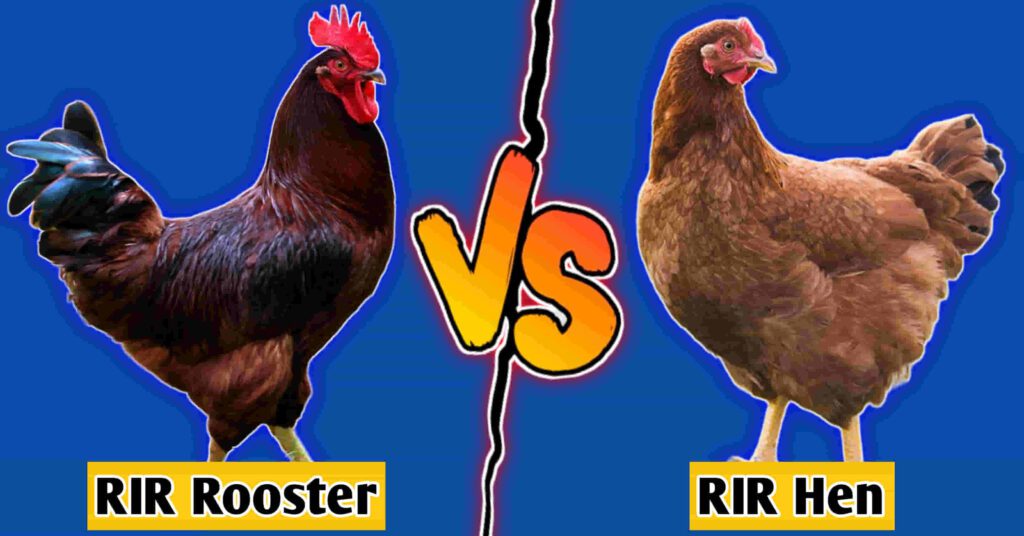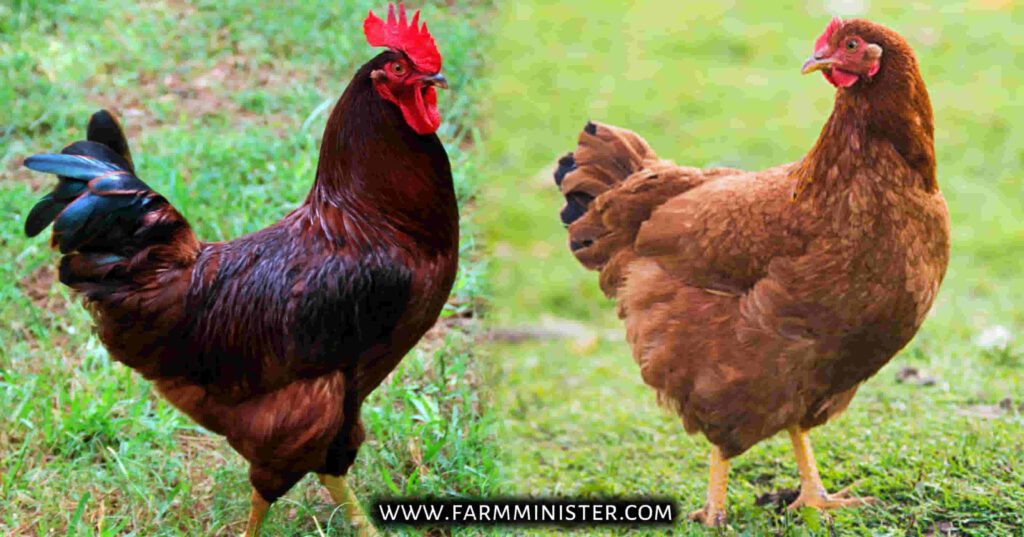Rhode Island Reds (RIR) are a popular breed of chicken, they are known for their Higher egg-laying ability, hardiness and friendly temperament. However, there are some key differences between Rooster Vs Hen of this breed.

RIR Rooster Vs Hen
Rhode Island Red (RIR) Rooster and Hens both are the beautiful and productive bird, but they both roosters and hens have different roles on their flock. The main role of an hen is to produce eggs, and an rooster helps to produce meat and fertilize the eggs that lay by hens.
| Characteristic | RIR Rooster | RIR Hen |
|---|---|---|
| Physical Appearance | Larger, robust frame | Petite, streamlined physique |
| Plumage Color | Vibrant shades of mahogany red | Lighter shade of mahogany red |
| Leadership and Protection | Alert, protective of the flock | Cooperative and social demeanor |
| Vocalizations | Crowing, assertive vocalizations | Communicative with softer clucks |
| Reproduction and Breeding | Mates with hens for fertilization | Lays fertilized eggs |
| Egg Production | Does not lay eggs | Consistently produces large brown eggs |
| Nurturing Behavior | Not involved in nesting or incubation | Exhibits strong maternal instincts |
| Social Dynamics | Asserts dominance within the flock | Establishes pecking order and hierarchy |
| Main Contribution to Flock | Protection, breeding, and warning | Egg production and fostering unity |
1) Physical Characteristics of RIR Rooster Vs Hen

RIR rooster and hen are both attractive and good looking birds, but there are some physical characteristics that differentiate or make them different in terms of looking. Here in bellow have mentioned some physical characteristics between the RIR rooster vs hen:
RIR Roosters
- Size: Larger than hens, weighing around 8.5 pounds.
- Color: Deep mahogany red/brown plumage, with darker and more vibrant feathers than hens.
- Comb: Large, single comb that is bright red.
- Spurs: Sharp, pointed growths on the back of the legs.
- Behavior: More aggressive than hens, crowing to mark their territory and attract hens. They will also fight with other roosters, especially during the breeding season.
- Eggs: Do not lay eggs.
RIR Hens
- Size: Smaller than roosters, weighing around 6.5 pounds.
- Color: Deep mahogany red/brown plumage, with some hens having dark black/green tail feathers.
- Comb: Smaller, single comb that is bright red.
- Spurs: Do not have spurs.
- Behavior: Less aggressive than roosters, docile and easy to handle. Do not crow.
- Eggs: Lay about 250 brown eggs per year.
2) Which is better for a backyard flock?
Whether you choose to keep a roosters or hens in your backyard flock, it is depending on your personal preferences needs, and goal. If you are looking for eggs than you can keep hens only. Apart from this, if you want only their meat, than you can keep rooster only.
However, if you want Meat, eggs and fertile eggs, that will help you extend your flock in future and also help protect your flock, then rooster and hens both may be a good choice for you.
Also Read: Rhode Island Blue Chicken
3) Which is Right for You?

The decision of whether to get a rooster or a hen, it’s all depends on your individual needs and preferences. You should keep some roosters along with hens in backyard chicken flock.
However, if you are looking for a chicken that is not much noisy and polite in nature, then only hens may be a better option for you. However, Here are some additional tips for choosing the right Rhode Island Red for your flock:
- If you are getting roosters, make sure to get at least two.
- If you are getting hens, you should mixing of different ages. This will help to ensure that all of the hens have a chance to lay eggs.
- No matter what gender you choose, make sure to get your chickens from a reputable breeder. This will help you to ensure that they are healthy and have pure breed.
Read More: Rhode Island Red Vs New Hampshire Chicken
Conclusion
Rhode Island Reds (RIR) are a great breed of chicken for both backyard flocks as well as commercial farms. They are hardy, easy to care and productive chicken that will produce lots of eggs for you.
Before getting Rhode Island Reds (RIR) for your flock, decide if you want a rooster or a hen. Roosters can be loud and cause trouble, but they also help to keep your flock safe from predators as well as extend the flock by matting with hens.
FAQs
Q1: Are Rhode Island Red chickens broody?
Ans: Yes, Rhode Island Red chickens can be broody. However, they are not as broody as some other breeds.
Q2: When do Rhode Island Red chickens start laying eggs?
Ans: Rhode Island Red chickens typically start laying eggs at around 18-20 weeks of age.
Q3: How long do Rhode Island Red chickens live?
Ans: Rhode Island Red chickens typically live for 5-8 years. However, some hens can live up-to 10 years.
Q4: Rhode Island Red chickens egg production?
Ans: Rhode Island Red hen can lay around 250-300 eggs per year and 5-6 eggs per week.